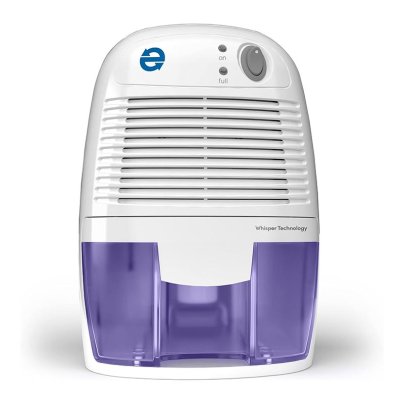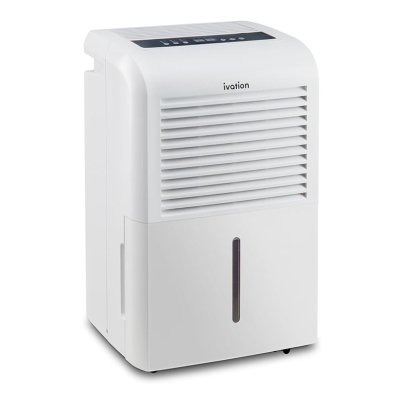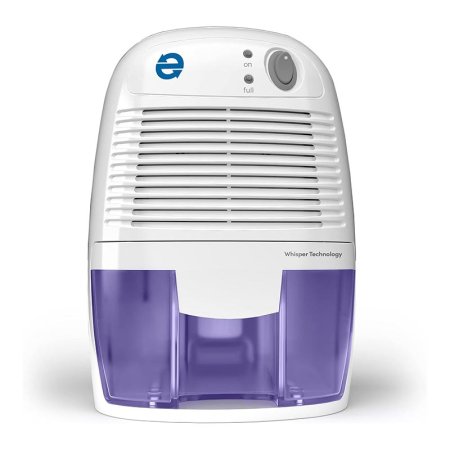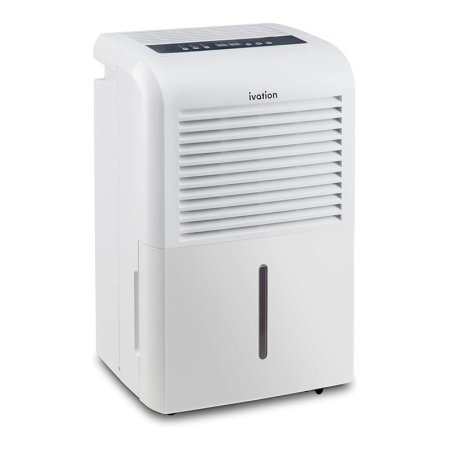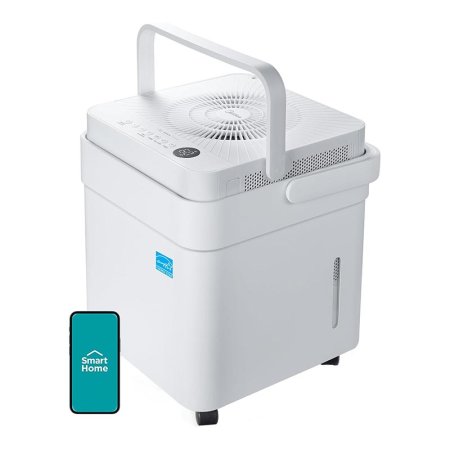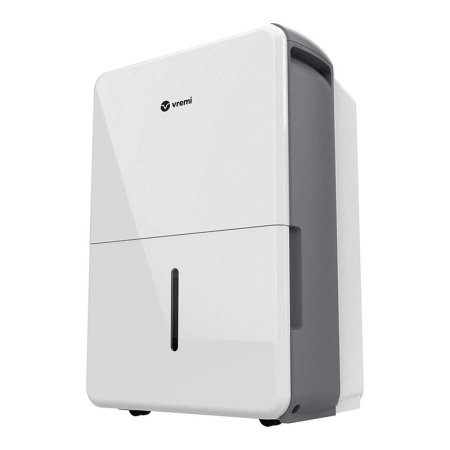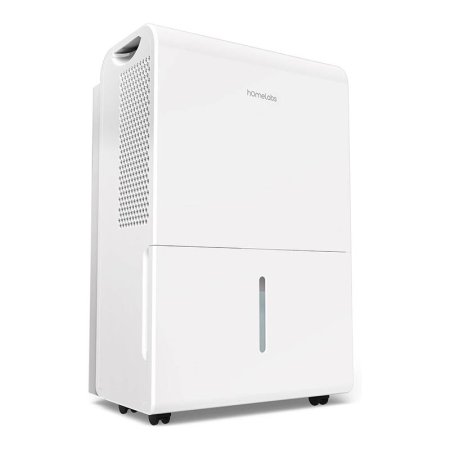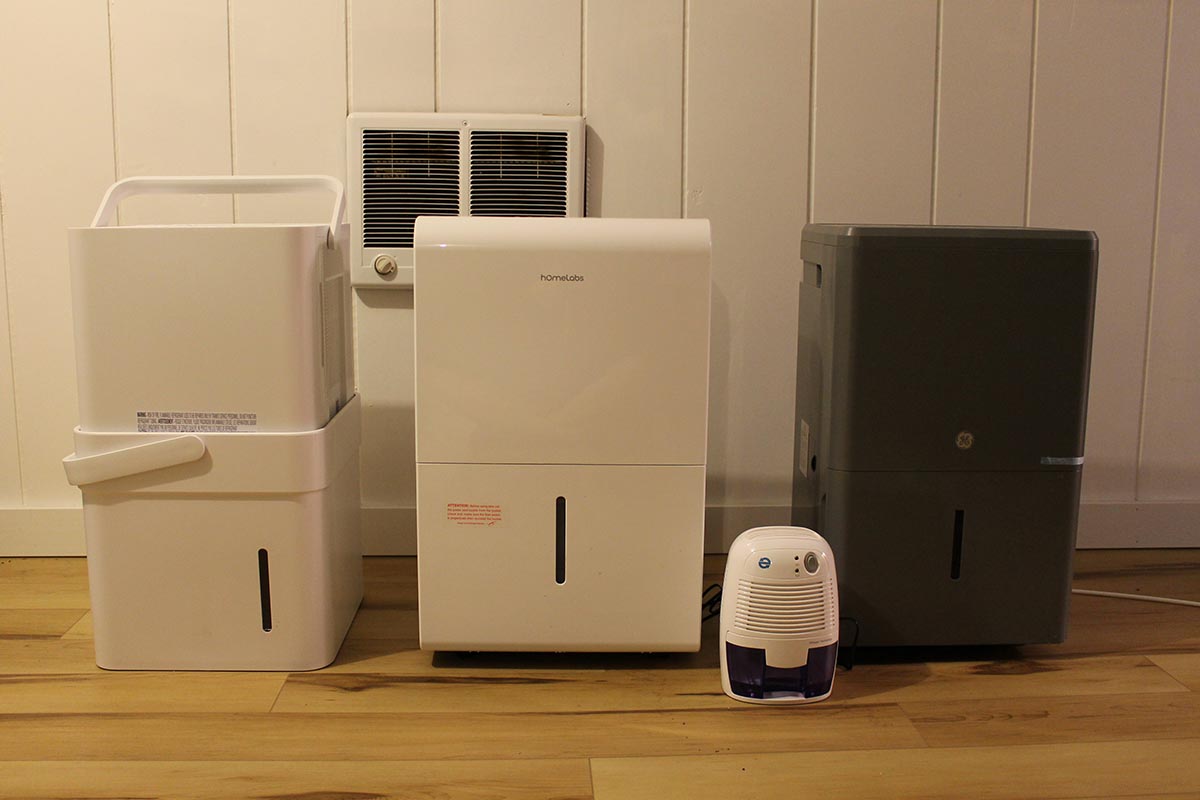
We may earn revenue from the products available on this page and participate in affiliate programs. Learn More ›
Homes with excess humidity not only feel sticky and uncomfortable but are at an increased risk for mold growth and bad smells, calling for the use of a dehumidifier. Dehumidifiers remove moisture from the air, emptying collected water through a continuous drain hose or into a removable tank. They come in different sizes and capacities and have a range of features and setting options. To help you find the right dehumidifier for your home based on size, budget, and personal preferences, we tested and compared seven popular models.
Our top pick, the GE 50-pint portable dehumidifier, can remove up to 50 pints of moisture from the air per day. It allows users to set target humidity levels, works with or without its included drain hose, and is easy to move around and empty.
The GE dehumidifier wasn’t the only model that performed well during our testing, though. Ahead, learn how to select the best dehumidifier for your house and find out why the following picks are good options for a variety of homes and lifestyles.
- BEST OVERALL: GE 50-Pint Portable Dehumidifier With Built-In Pump
↓ Jump to Review - BEST BANG FOR THE BUCK: Eva-Dry EDV-1100 Petite Dehumidifier
↓ Jump to Review - BEST FOR BASEMENTS: Ivation Large-Capacity Dehumidifier With Pump
↓ Jump to Review - BEST CRAWL SPACE UNIT: AprilAire E070 70-Pint Crawl Space Dehumidifier
↓ Jump to Review - BEST SMART DEHUMIDIFIER: Midea 50-Pint Cube Dehumidifier
↓ Jump to Review - BEST QUIET DEHUMIDIFIER: Vremi 22-Pint 1,500-Square-Foot Dehumidifier
↓ Jump to Review - BEST FOR LARGE ROOMS: hOmeLabs 35-Pint 3,000-Square-Foot Dehumidifier
↓ Jump to Review
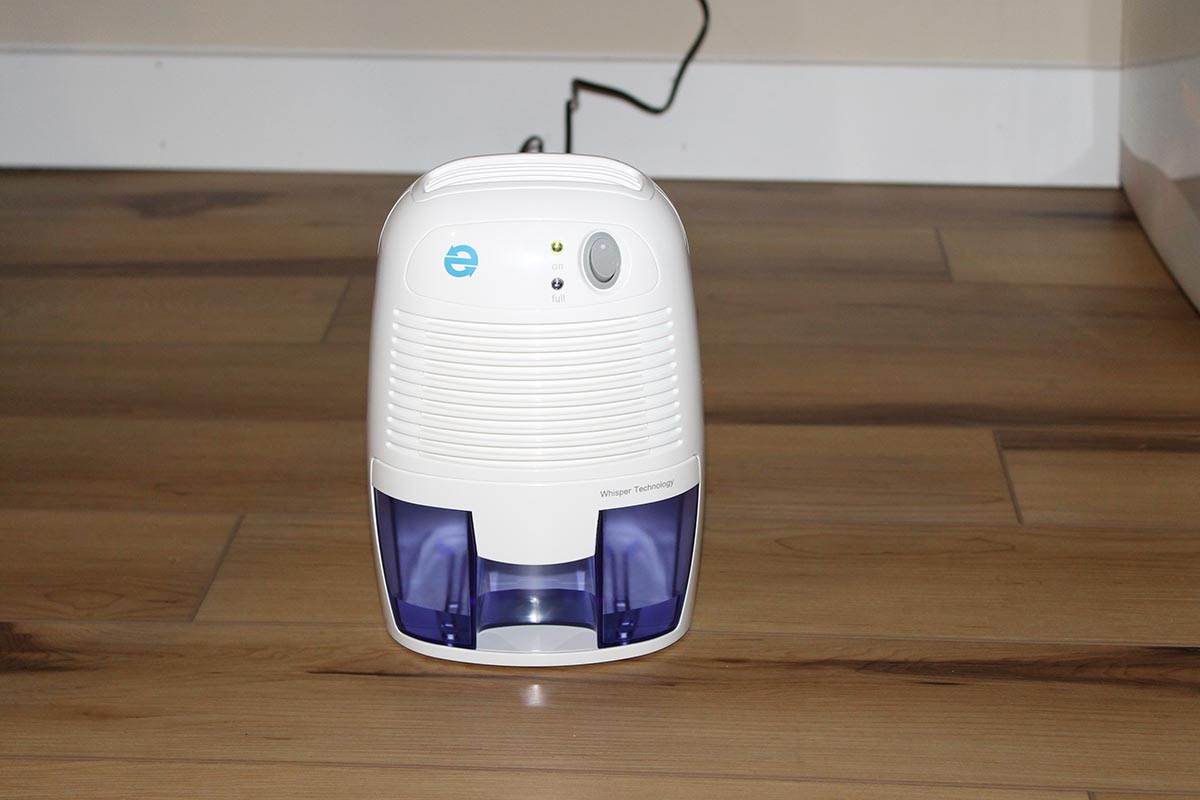
| Testing Stats | |
| Products tested | 7 |
| Time spent testing | 4 weeks |
| Amount of water removed from air | 1,700 pints |
| Price range | $46 to $1,500 |
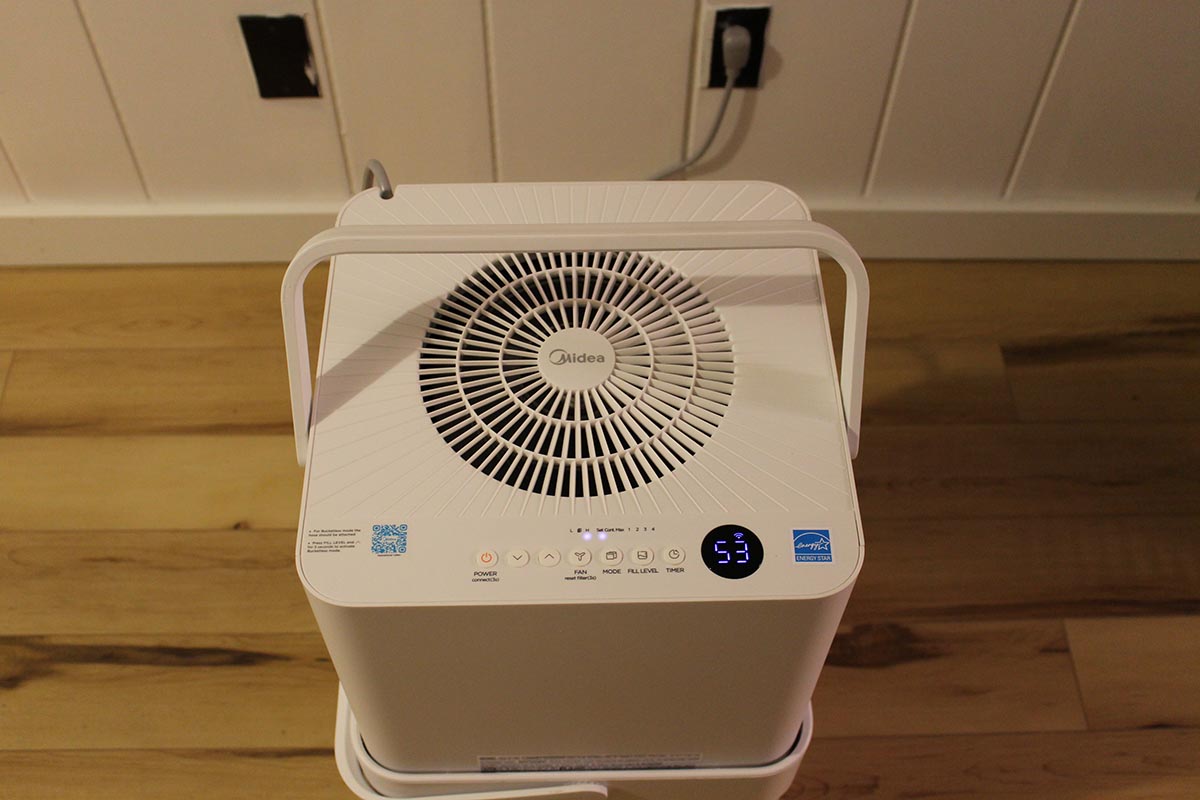
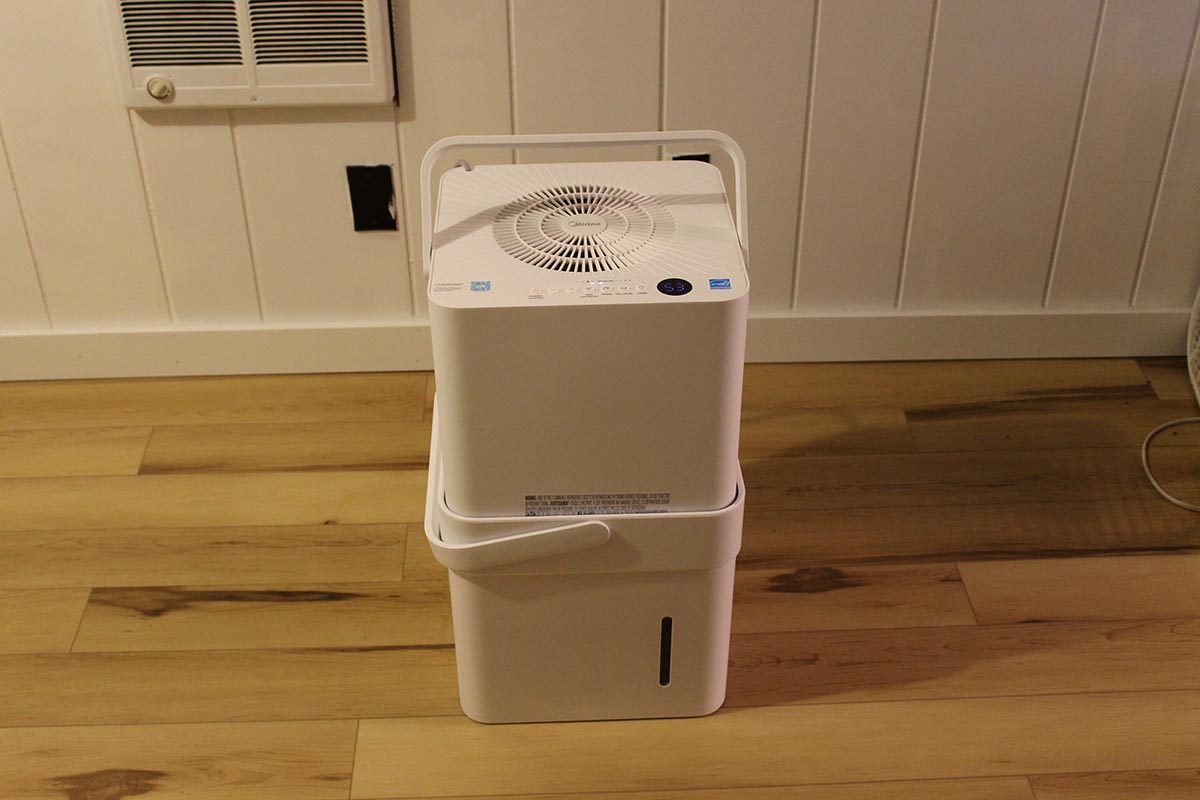
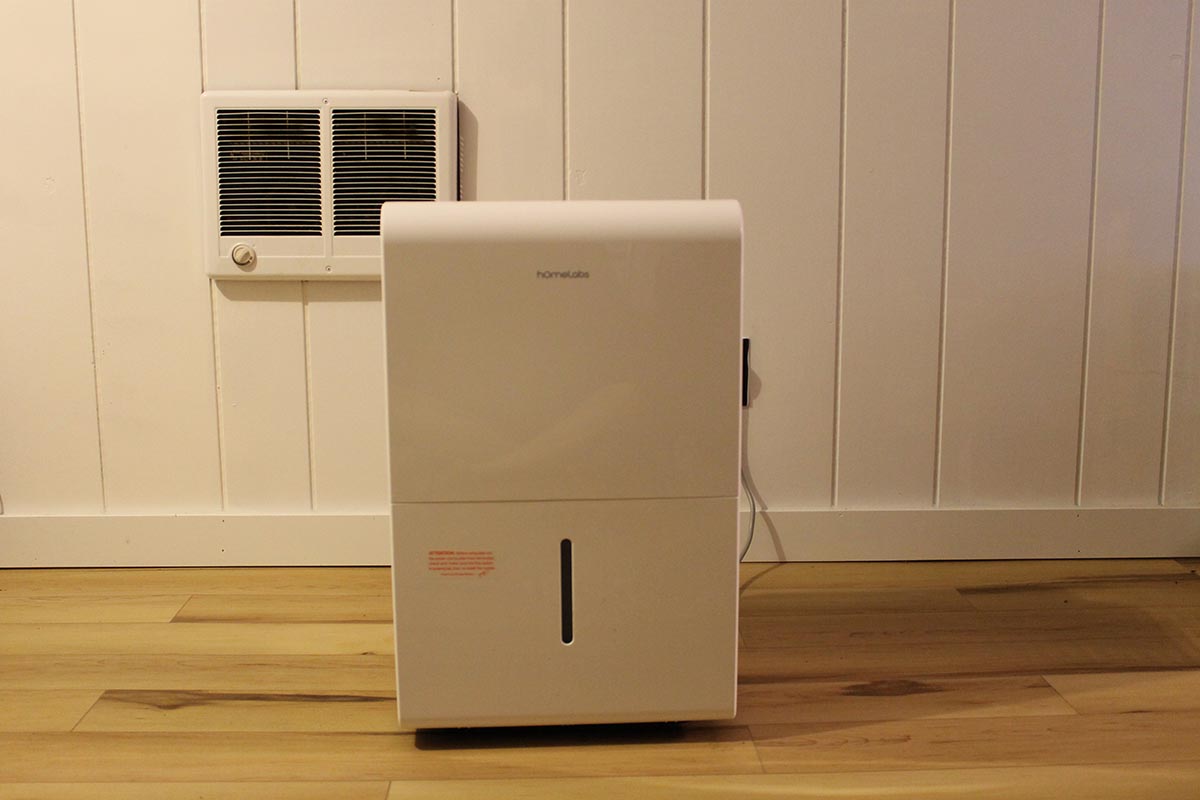
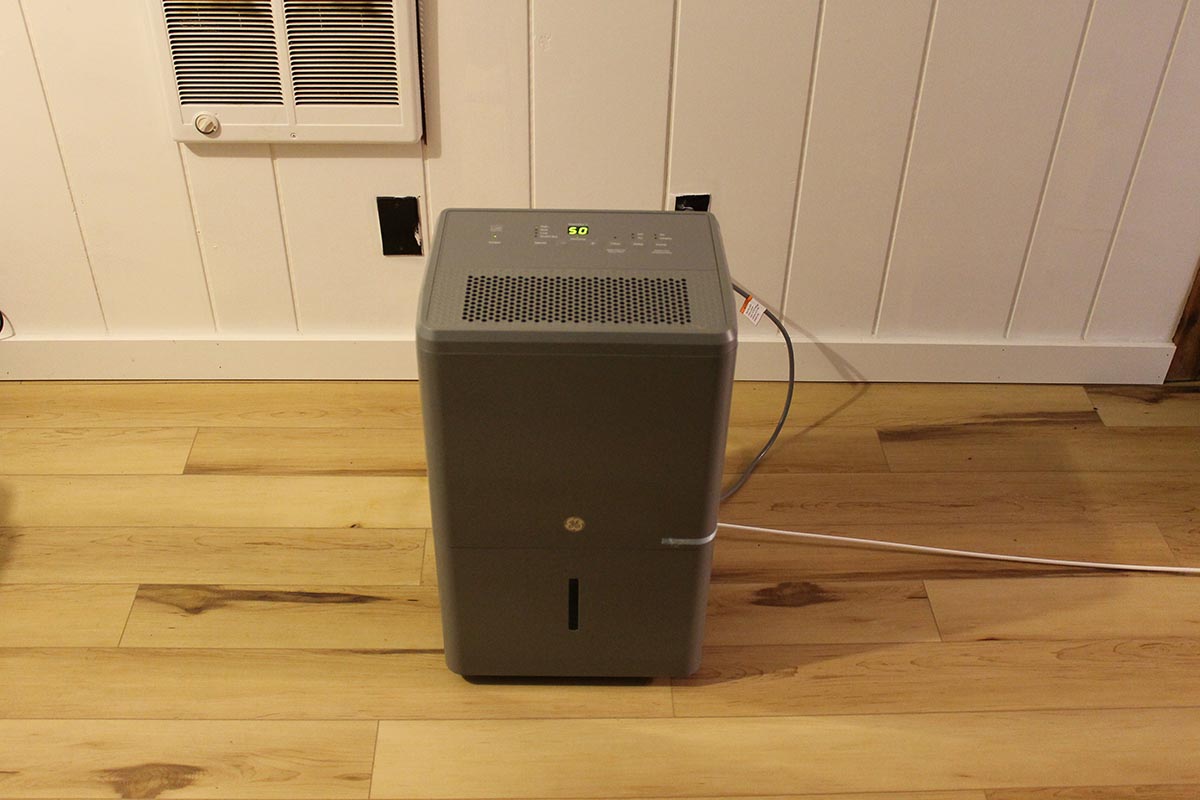
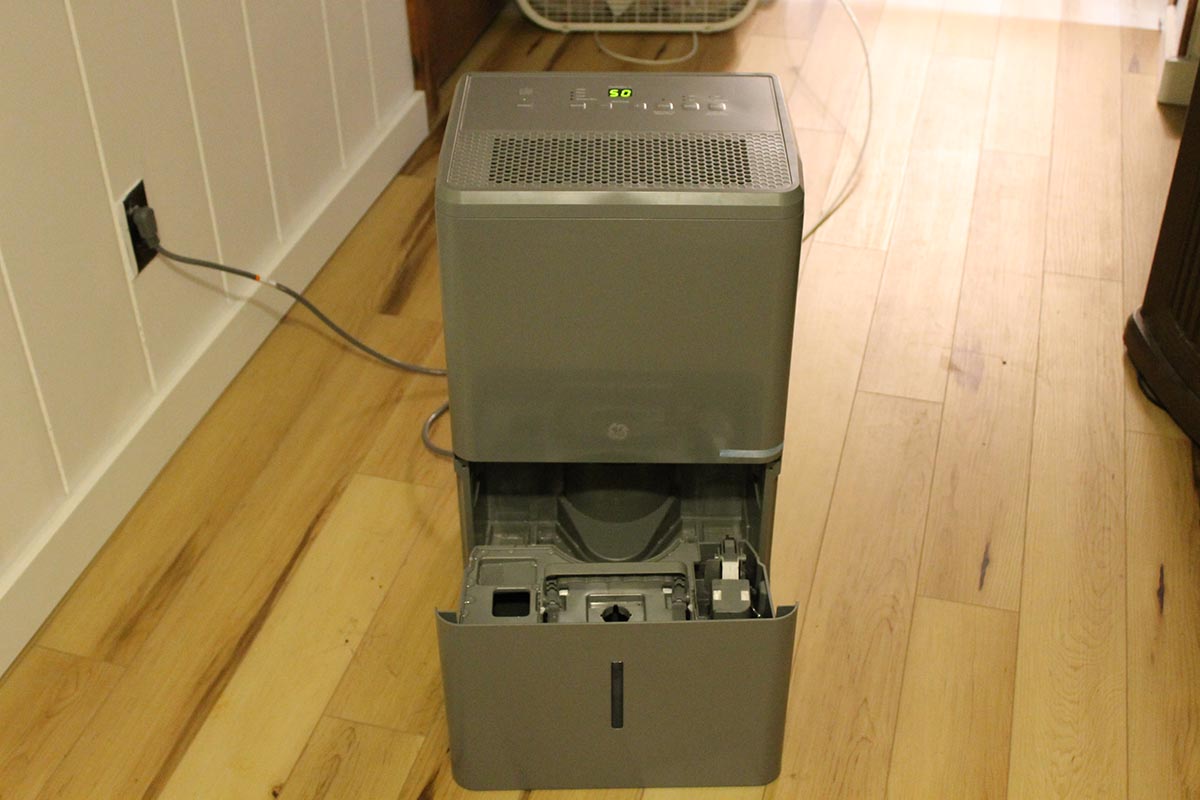
Our Top Picks
To qualify as a top pick, a dehumidifier needs to be efficient, durable, and easy to operate. The best dehumidifier for your home will depend on how much humidity is present, whether you plan on dumping a collection tank or if you’d prefer a drain hose, and the size of your room. The following dehumidifiers will remove unwelcome humidity in a variety of situations.
Best Overall
GE 50-Pint Portable Dehumidifier With Built-In Pump
Our Ratings: Ease of Use 5/5; Noise 4.5/5; Effectiveness 4.5/5; Value 4.7/5
Product Specs
- Capacity: 50 pints
- Coverage: 4,500 square feet
- Energy Star certified: Yes
What We Like
- Empties via the bucket or drain hose
- 3 speed settings; very quiet on lowest speed
- Easy to move around and empty
- Adjustable humidistat ranges between 30 percent and 70 percent
What We Don’t Like
- It’s a little loud on highest fan speed
While any dehumidifier can remove moisture from the air, a large-capacity unit is best for large rooms, open floor plans, and basements. This GE model can remove up to 50 pints of water per day and keep spaces up to 4,500 square feet dry. It includes many useful features, such as an adjustable humidistat, a digital LED display, auto defrost, and an auto-restart feature that powers the dehumidifier back on in case of a power outage.
One of our favorite things about this model was its ability to work with or without the drain hose. We initially tested the drain hose and pump, setting the dehumidifier in our basement and running the hose to a floor drain. We set our target humidity level at 40 percent, and the self-draining dehumidifier kicked on and off intermittently, keeping basement humidity levels in the 40 percent range without our intervention. We also used the dehumidifier without the hose; the bucket filled within 24 hours and was easy to dump.
This model has three fan speeds and a Smart Dry feature that automatically adjusts the fan based on detected humidity levels. At its lowest speed, this dehumidifier runs very quietly. It’s a little loud on the highest fan setting, which is comparable to most other dehumidifiers we tested.
Get the GE dehumidifier at The Home Depot.
Best Bang for the Buck
Eva-Dry EDV-1100 Petite Dehumidifier
Our Ratings: Ease of Use 5/5; Effectiveness 2.5/5; Noise 5/5; Value 4/5
Product Specs
- Capacity: 8 ounces
- Coverage: 1,100 cubic feet
- Energy Star certified: No
What We Like
- Small dehumidifier that’s ideal for RVs, closets, and bathrooms
- Whisper-quiet operation
- Auto restart and auto shut-off features
What We Don’t Like
- Not effective in large spaces
- Works very slowly
When there are moisture issues in a small space such as an RV, closet, or bathroom, standard-size dehumidifiers may not fit. Fortunately, small space dehumidifiers, like the Eva-Dry EDV-1100, suit even the tiniest spots and can help remove humidity from the air. At only 8.5 inches tall by 6.5 inches wide by 5 inches deep, the Eva-Dry is compact enough to sit on a bathroom counter or closet floor and weighs only 2 pounds.
Rather than setting a humidity target level like a standard dehumidifier, the Eva-Dry has only two settings: on and off. To see how well it could collect moisture from the air, we placed it in our basement with 65 percent humidity levels. After just a single day, its 16-ounce collection tank was a quarter of the way full, and after 48 hours, it was almost halfway full. We emptied the water by removing the collection tank from the dehumidifier and dumping it down the drain.
While this model wasn’t equipped to handle our large, humid basement, it is a nice-to-have model for smaller spaces and is designed to work as a closet, bedroom, or bathroom dehumidifier. It has an auto-restart feature, so it will power back on in the event of a power outage, and its auto shut-off feature will display an indicator light when the tank is full.
Get the Eva-Dry dehumidifier at Amazon.
Best for Basements
Ivation Large-Capacity Dehumidifier With Pump
Our Ratings: Ease of Use 4.5/5; Noise 4/5; Effectiveness 4.5/5; Value 4/5
Product Specs
- Capacity: 50 pints
- Coverage: 4,500 square feet
- Energy Star certified: Yes
What We Like
- Includes 16-foot hose for continuous operation
- Maintains humidity levels in large spaces
- Includes timer, auto shutoff, and frost sensor features
What We Don’t Like
- A bit noisy
A basement is often the most humid spot in the house, but with this Ivation large-capacity dehumidifier, basements can stay dry and comfortable. It comes with a 2.25-gallon collection tank, but it operates best when connected to a drain hose for hands-free emptying into a floor drain.
Designed to remove humidity from areas up to 4,500 square feet, the Ivation is powerful enough to tackle the toughest humidity problems, making it an ideal dehumidifier for mold issues in the basement. It’s also simple to operate: Users can choose either timed mode or continuous mode, which means the unit will run until it’s shut off or the tank fills.
The Ivation dehumidifier for basement spaces comes with a 16-foot hose for continuous use, but we also tested its collection bucket. Among the large-capacity dehumidifiers we tested, this one had the longest runtime before it needed to be emptied. It was easy to move, and the onboard condensate pump allowed us to empty the unit into a sink drain. We appreciated this unit’s auto-restart feature, which powers it back on in the event of a power failure. It also has an auto-defrost sensor that protects its evaporator coils.
Get the Ivation dehumidifier at Amazon, Wayfair, Walmart, or Target.
Best Crawl Space Unit
AprilAire E070 70-Pint Crawl Space Dehumidifier
Our Ratings: Ease of Use 5/5; Noise 5/5; Effectiveness 5/5; Value 4/5
Product Specs
- Capacity: 70 pints
- Coverage: 2,200 square feet
- Energy Star certified: No
What We Like
- Large water-removal capacity for big crawl spaces
- Features corrosion-resistant aluminum coils
- Automatically kicks on when humidity rises above target
- Gravity drain system
What We Don’t Like
- Can’t pump to an elevated drain
- Heavier than other models with similar capacity
Homes in rainy regions with sealed crawl spaces are at high risk of humidity-related problems. When you need serious moisture reduction in a humid crawl space to protect your home’s structure, consider a unit such as the AprilAire E070. This dehumidifier for house crawl spaces removes up to 70 pints of moisture per day, and there’s no collection tank to dump. Instead, it automatically empties the water through a hose (included) outside the home or to a floor drain.
We had previously tested five popular crawl space dehumidifiers, and while this was one of the most expensive, it was the clear winner in ease of use and effectiveness. It had a simple interface and a large display that made it easy for us to set up. It also has other valuable features, including corrosion-resistant aluminum coils, a gravity drain, and a washable air filter to ensure it will operate smoothly for years.
Thanks to the easy-to-follow directions, installing this dehumidifier took us only 15 minutes. The starting humidity level in our crawl space was 70 percent. After 12 hours, it dropped to 58 percent, and within 24 hours, it was at 49 percent. The dehumidifier continued to run intermittently, keeping humidity levels in the mid 40s.
Get the AprilAire dehumidifier at Amazon or The Home Depot.
Best Smart Dehumidifier
Midea 50-Pint Cube Dehumidifier
Our Ratings: Ease of Use 3.7/5; Noise 4/5; Effectiveness 5/5; Value 3.3/5
Product Specs
- Capacity: 50 pints
- Coverage: 4,500 square feet
- Energy Star certified: Yes
What We Like
- Large 4.2-gallon bucket requires less emptying
- Ability to control from smartphone app
- Continuous drain option
What We Don’t Like
- Heavy and awkward to empty
- App has limited features
Smartphone-compatible home devices allow users to control important settings with a few clicks. For those shoppers who appreciate smart features, the Midea 50-pint cube dehumidifier is an option worth considering; its smartphone app is compatible with Android and iOS devices. The unique nested design simplifies storage, and it’s easy to lift and twist the sections apart when it’s time to use.
Our initial impression of the Midea dehumidifier was that it was heavy. To set it up, we had to lift the top unit and set it inside its water collection bucket, carefully lining up arrows for correct installation. We then connected the app and set a target humidity level of 40 percent. It only took 2 hours for the Midea to bring our basement from 55 percent humidity to 40 percent. For the next 24 hours, humidity levels remained in the low to mid 40s.
The Midea app notified us when the bucket was full, about 24 hours after the initial setup. To empty this large dehumidifier, we had to lift the top unit from the bucket, set it on the floor, and pour the collected water out of the bottom bucket. The dehumidifier weighs just under 42 pounds in total, with most of the weight concentrated at the top dehumidifying unit. While this unit is efficient and has smart features, we don’t recommend it to those who have difficulty lifting heavy objects.
Get the Midea dehumidifier at Amazon or The Home Depot (with pump).
Best Quiet Dehumidifier
Vremi 22-Pint 1,500-Square-Foot Dehumidifier
Our Ratings: Ease of Use 4/5; Effectiveness 5/5; Noise 4/5; Value 4.5/5
Product Specs
- Capacity: 22 pints
- Coverage: 1,500 square feet
- Energy Star certified Yes
What We Like
- Turbo mode rapidly dehumidifies a room
- Affordably priced for the features
- Has anti-frost setting
- Lightweight and easy to carry
What We Don’t LIke
- Small water tank capacity
The Vremi dehumidifier can remove up to 22 pints of moisture from the air per day in areas up to 1,500 square feet. It operates at a consistent speed to keep humidity at a comfortable level, but if you come home to a sticky house, just switch on the turbo mode to increase air movement to quickly air-dry the house.
The machine will shut off if the collection tank fills up. Still, if you have a floor drain nearby—such as in a utility room—you can connect a drain hose (sold separately) to the Vremi and drain the collected water directly into the floor drain without worrying about dumping the tank. It has an auto-defrost feature to prevent coils from freezing and a memory feature to auto restart in the event of a power outage.
The Vremi has a sleeker look than other dehumidifiers we tested. It felt lightweight and was easy to move around thanks to its caster wheels and built-in handles. It did a nice job of removing humidity from our basement, although the small water tank required frequent emptying. It’s a suitable size for most spaces and could even work as a garage dehumidifier.
Get the Vremi dehumidifier at Amazon or Vremi.
Best for Large Rooms
hOmeLabs 35-Pint 3,000-Square-Foot Dehumidifier
Our Ratings: Ease of Use 5/5; Effectiveness 5/5; Noise 3.5/5; Value 4/5
Product Specs
- Capacity: 35 pints
- Coverage: 3,000 square feet
- Energy Star certified: Yes
What We Like
- Empties via collection tank or continuous drain hose
- Turbo mode for fast dehumidifying
- Easy to operate and move
What We Don’t Like
- A little louder than some comparable models
Large spaces, such as open floor plans and basements, require a dehumidifier that can remove enough moisture from the air to keep humidity levels regulated. The hOmeLabs 35-pint dehumidifier is effective in spaces up to 3,000 square feet, making it a suitable option. It has built-in wheels and a carry handle for easy portability, plus essential features such as auto shutoff, a timer, and a filter indicator light.
Setting up the hOmeLabs dehumidifier was as simple as plugging it in and powering it on. We set the humidity level to 40 percent, and it started reducing excess moisture in our basement. We allowed this dehumidifier to run for 2 weeks, and it removed more than 22 collective gallons of water from the air.
The collection tank filled up within 24 hours during continuous use, so we had to empty it daily. Emptying it was easy, but fortunately, this model also has a drain hose connection for continuous draining. (Drain hose sold separately.) The hOmeLabs dehumidifier has a sleek look, is easy to move around, and doesn’t take up much space. However, it was a little louder than comparable dehumidifiers that we tested.
Get the hOmelabs dehumidifier at Amazon, Wayfair, or Walmart.
Jump to Our Top Picks
How We Tested the Best Dehumidifiers
After researching 10 popular brands and over 30 models, we selected seven dehumidifiers for testing. We chose models that could suit large and small spaces and fit a wide range of budgets.
With the exception of the crawl space dehumidifier, our main testing spaces included basements with 40 percent to 70 percent humidity levels. The crawl space dehumidifier was tested in a crawl space with a 2-year-old vapor barrier.
We evaluated each dehumidifier’s ability to reduce the humidity in our homes. We also assessed each one based on how easy it was to set up and empty, how noisy it was, and any extra features it had (such as smart capabilities, turbo dehumidifying, and drainage hoses). Subjective tests included how the air in our basement felt and smelled while each dehumidifier ran. All results were kept in a standardized rubric, where we assigned each dehumidifier a score of 0 to 5 based on ease of use, effectiveness, noise, and value.
What to Consider When Buying a Dehumidifier
Humidity is directly related to comfort, and humidity levels higher than 50 percent will make a room feel sticky during hot weather and downright chilly when the temperature drops. If you’re unsure whether your home would benefit from a dehumidifier, purchase an air quality monitor to assess humidity levels beforehand. In addition to selecting the right type of dehumidifier for your situation, also consider the following factors.
Hose Connection
Some smaller dehumidifiers have collection tanks that must be manually removed and dumped when they get full. Larger dehumidifiers with pump features often have a collection tank in addition to a hose connection that allows the user to run a drain hose from the dehumidifier to a floor drain or a sump pump. The connection accepts a standard garden hose, which is typically sold separately.
Filter Indicator
Most models come with filters that need to be replaced or washed when they become clogged to keep dust and dirt from entering the working parts of a dehumidifier. The dehumidifier may have a filter light that comes on, or, in some cases, it might throw a digital error code to let you know the filter is dirty, indicating the unit is struggling to draw air through the clogged filter. When a filter is clogged, the unit’s effectiveness is reduced.
Automatic Humidistat
As long as a dehumidifier is running, it’s lowering humidity in the house, but once the humidity level in the room falls below 30 percent, a dehumidifier doesn’t offer much benefit. If it comes with an automatic humidistat, you won’t have to manually switch the unit on and off to control the humidity. Instead, you can select the humidity level that feels best to you. The machine will automatically monitor the air’s moisture and turn on only when the humidity exceeds that number. When the humidity level drops, the unit will turn off again.
Capacity
When it comes to dehumidifiers, capacity indicates how much moisture the machine can remove from the air in 24 hours if it runs continuously. Capacity and collection-tank sizes are not the same thing, however. A 20-pint dehumidifier might have a 1-gallon collection tank that needs to be dumped repeatedly to reach the 20-pint total in a day. In general, if a room is moderately humid, meaning the humidity level is around 65 percent to 70 percent, the following dehumidifier size will be suitable for the corresponding room size.
- A 30-pint dehumidifier will effectively treat a room of 500 to 1,500 square feet.
- A 50-pint dehumidifier is ideal for a space that’s 2,000 to 2,500 square feet.
- A 70-pint dehumidifier will treat a room that’s 2,500 to 3,000 square feet.
If the humidity is higher than 70 percent, consider opting for a higher-capacity dehumidifier.
Types of Dehumidifiers
Dehumidifiers can work in various ways to remove moisture from the air. Whether you need just a little drying action or a lot, the dehumidifier you choose will be one of the following three types.
Refrigerant
A refrigerant dehumidifier works by cooling a steel surface within the machine, and when air is drawn over the cold steel, the moisture in the air condenses—much like what happens when warm air condenses on the side of a glass of iced tea. The condensation is collected in a tank or drains from a hose into a floor drain. Refrigerant units work best in rooms where the temperature is more than 65 degrees Fahrenheit—at lower temperatures, condensation is not as significant.
Desiccant
Sometimes called “chemical absorbent dehumidifiers,” desiccant units feature internal cartridges made from moisture-absorbing gel or powder. As air flows into the machine, the desiccant collects the moisture, which then drains into a collection tank or out via a drain hose. This type of dehumidifier works well in warm and cold temps, making it well suited to a cool basement or garage workshop.
Whole-House System
A whole-house dehumidifier is installed on a home’s central HVAC duct and removes moisture from the air whenever the furnace or air conditioner is running. Whole-house dehumidifiers work well in humid climates where homeowners would otherwise need to run multiple dehumidifiers to keep the indoor humidity at an acceptable level. To ensure proper installation, a licensed HVAC technician should install a whole-house dehumidifier.
The Advantages of Using a Dehumidifier
Keeping a home’s humidity level manageable can make its occupants feel more comfortable and protect the home and its contents.
- Lower humidity reduces the risk of mold and mildew growth.
- A dehumidifier will make a room feel more comfortable all year long.
- High humidity levels can lead to condensation forming on windows and even walls.
FAQs
If this is the first time you’ve shopped for a dehumidifier, you likely have some questions.
If you want to move it from room to room, get a portable unit. If there’s nowhere to run a drain hose, you’ll have to settle for a dehumidifier that needs to be dumped manually. And if you want your entire house dehumidified, opt for a whole-house unit.
For it to work most effectively, the best spot to place a dehumidifier is usually where it’s the most humid, such as in a kitchen, laundry room, unvented bathroom, or basement.
This will depend on how often the machine is running. Many of today’s models come with a filter warning light that indicates when you should clean or replace a dirty filter.
Depending on their size, dehumidifiers can use a lot of electricity. To find an energy-efficient dehumidifier, look at the wattage and opt for Energy Star–certified models.
Meet the Tester
Katie Barton has over 10 years of experience in home and garden writing. She has authored hundreds of articles for major media outlets, and her work has been featured on GOBankingRates, Realtor.com, Yahoo!, Cabin Life, and more. She takes an unbiased approach to product testing, using each product multiple times or for several days or weeks to determine efficacy.
Additional research provided by Glenda Taylor.

